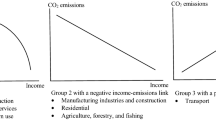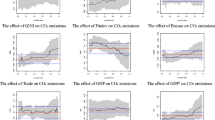Abstract
The nexus between economic growth and environmental conditions in BRICS countries for the period 2005–2018, using a Panel Corrected Standard Errors methodology considering cross-sectional dependence, heterogeneous slope coefficients, and aggregate data on four sectors of the economy: agriculture and forestry, industries (including construction), commercial and public services, and transportation, were studied. The study employs a set of covariates such as per sector electricity, coal, oil consumption, sectoral Gross Value Added, and carbon dioxide (CO2) emissions to account for sectoral income and environmental degradation. This study further contributes to the literature by being one of the pioneering works that examine the environmental Kuznets relationship at the sectoral level in the BRICS countries. It was revealed that sectoral income has a positive and statistically significant effect on CO2 emissions for the industrial sector and a negative and statistically significant effect on CO2 emissions for the commercial and public utilities sectors. It was confirmed for Russia that the relationship between income growth in the transportation sector is a U-shaped Kuznets curve. So as income growth, this will result in further environmental damage. The Russian and South African agriculture and forestry sector and the Chinese commercial and public services sector revealed an inverted U-shaped curve.

Similar content being viewed by others
Availability of data and materials
Not applicable.
References
Ozturk, I.: Sustainability in the food-energy-water nexus: Evidence from BRICS (Brazil, the Russian Federation, India, China, and South Africa) countries. Energy 93, 999–1010 (2015)
Williamson, S.D.: Macroeconomics (Fifth Edition, International Edition). Pearson, London (2014)
OECD: OECD Economic Outlook, Vol 2012/2. OECD Publishing, Durham (2012)
The World Bank.: World Development Indicators. Washington, D.C.: The World Bank (producer and distributor). Available at: https://data.worldbank.org/indicator (2019). Accessed 06 Jan 2020
BP Statistical Review of World Energy (2019). Available at: https://www.bp.com/content/dam/bp/businesssites/en/global/corporate/pdfs/energy-economics/statistical-review/bp-stats-review-2019-full-report.pdf. Accessed 10 Jan 2020
Grossman, G., Krueger, A.: Economic growth and the environment, WP-4634. National Bureau of Economic Research, Cambridge (1994)
Ummalla, M., Samal, A.: The impact of natural gas and renewable energy consumption on CO2 emissions andeconomic growth in two major emerging market economies. Environ Sci Pollut Res 26, 20893–20907 (2019)
Jorgenson, A.K., Clark, B.: Are the economy and the environment decoupling? A comparative international study, 1960–2005. Am. J. Sociol. 118, 1–44 (2012)
York, R., Rosa, E.A., Dietz, T.: A rift in modernity? Assessing the anthropogenic sources of global climate change with the STIRPAT model. Int. J. Sociol. Soc. Policy 23, 31–51 (2003)
Granados, J.A.T., Carpintero, O.: Dispelling the smoke: CO2 emissions and economic growth from a global perspective. Working Paper, University of Michigan (2009). http://sitemaker.umich.edu/tapia_granados/files/co2_emissions_and_gdp_growth_-_dec_2009_-_f2.pdf. Accessed 5 Jan 2014
Piaggio, M., Padilla, E.: CO2 emissions and economic activity: Heterogeneity across countries and non-stationary series. Energy Policy 46, 370–381 (2012)
Rosa, E.A., Dietz, T.: Human drivers of national greenhouse-gas emissions. Nat. Clim. Change 2, 581–586 (2012)
Knight, K.W., Schor, J.B.: Economic growth and climate change: a cross-national analysis of territorial and consumption-based carbon emissions in high-income countries. Sustainability 6, 3722–3731 (2014)
Bölük, G., Mert, M.: The renewable energy, growth and environmental Kuznets curve in Turkey: An ARDL approach. Renew. Sustain. Energy Rev. 52, 587–595 (2013)
Dogan, E., Seker, F.: Determinants of CO2 emissions in the European Union: The role of renewable and non-renewable energy. Renew. Energy 94, 429–439 (2016)
Aslanidis, N., Iranzo, S.: Environment and development: Is there a Kuznets curve for CO2 emissions? Appl. Econ. 41(6), 803–810 (2009)
Chiu, Y.: Deforestation and the environmental Kuznets Curve in developing countries: A panel smooth transition regression approach. Can. J. Agric. Econ. 60(2), 177–194 (2012)
Hossain, S.: Panel estimation for CO2 emissions, energy consumption, economic growth, trade openness and urbanization of newly industrialized countries. Energy Policy 39(11), 6991–6999 (2011)
Aye, G.C., Edoja, P.E.: Effect of economic growth on CO2 emission in developing countries: Evidence from a dynamic panel threshold model. Cogent Econ. Fin. 5, 1 (2017). https://doi.org/10.1080/23322039.2017.1379239
Beyene, S.D., Kotosz, B.: Testing the environmental Kuznets curve hypothesis: An empirical study for East African countries. Int. J. Environ. Stud. (2019). https://doi.org/10.1080/00207233.2019.1695445
Abokyi, E., Appiah-Konadu, P., Abokyi, F., Oteng-Abayie, E.F.: Industrial growth and emissions of CO2 in Ghana: The role of financial development and fossil fuel consumption. Energy Rep. 5, 1339–1353 (2019)
Alam, J.: Impact of agriculture, industry and service sector’s value added in the GDP on CO2 emissions of selected South Asian countries. World Rev. Bus. Res. 5(2), 39–59 (2015)
Nordhaus, W.: Economic aspects of global warming in a post-Copenhagen environment. Proc. Natl. Acad. Sci. 107(26), 11721–11726 (2010). https://doi.org/10.1073/pnas.1005985107
Stern, D., van Dijk, J.: Economic growth and global particulate pollution concentrations. Clim. Change 142(3), 391–406 (2017)
Ru, M., Shindell, D.T., Seltzer, K.M., Tao, S., Zhong, Q.: The long-term relationship between emissions and economic growth for SO2, CO2, and BC. Environ. Res. Lett. 13, 124021 (2018)
Sohag, K., Al Mamun, M., Uddin, G.S., Ahmed, A.M.: Sectoral output, energy use, and CO2 emission in middle-income countries. Environ. Sci. Pollut. Res. 24, 9754–9764 (2017)
Liddle, B.: The energy, economic growth, urbanization nexus across development: evidence from heterogeneous panel estimates robust to cross-sectional dependence. Energy J. 34(2), 223–244 (2013)
Driscoll, J.C., Kraay, A.C.: Consistent covariance matrix estimation with spatially dependent panel data. Rev. Econ. Stat. 80, 549–560 (1998)
Pesaran, M.H.: A simple panel unit root test in the presence of cross-section dependence. J. Appl. Econom. 22(2), 265–312 (2007)
Hoechle, D.: Robust standard errors for panel regressions with cross-sectional dependence. Stata J. 7(3), 281–312 (2007)
Parks, R.: Efficient estimation of a system of regression equations when disturbances are both serially and contemporaneously correlated. J. Am. Stat. Assoc. 62, 500–509 (1967)
Beck, N., Katz, J.N.: What to do (and not to do) with Time-Series Cross-Section Data. Am. Polit. Sci. Rev. 89(3), 634–647 (1995)
Greene, W.H.: Econometric Analysis. Prentice-Hall, Upper Saddle River (2003).. (ISBN 0-13-066189-9)
Sasana, H., Ghozali, I.: The impact of fossil and renewable energy consumption on the economic growth in Brazil, Russia, India, China and South Africa. Int. J. Energy Econ. Policy 7(3), 194–200 (2017)
Ruggiero, S., Lehkonen, H.: Renewable energy growth and the financial performance of electric utilities: a panel data study. J. Clean. Prod. 142(4), 3676–3688 (2017)
Gu, J., Renwick, N., Xue, L.: The BRICS and Africa’s search for green growth, clean energy and sustainable development. Energy Policy 120, 675–683 (2018)
Simonova, M., Zakrahov, V.E., Mamiy, I.: Prospects of renewable energy sources: The case study of the BRICS countries. Int. J. Energy Econ. Policy 9(5), 186–193 (2019)
Zhou, A., Li, J.: Heterogeneous role of renewable energy consumption in economic growth and emissions reduction: Evidence from a panel quantile regression. Environ. Sci. Pollut. Res. 26(22), 22575–22595 (2019)
Zhang, Y.J., Jin, Y.L., Shen, B.: Measuring the energy saving and CO2 emissions reduction potential under China’s Belt and Road Initiative. Comput. Econ. 55, 1095–1116 (2020). https://doi.org/10.1007/s10614-018-9839-0
Funding
CeBER R&D unit funded by national funds through FCT–Fundação para a Ciência e a Tecnologia, I.P., project UIDB/05037/2020; NECE, R&D unit funded by national funds through FCT–Fundação para a Ciência e a Tecnologia, I.P., project UIDB/04630/2020.
Author information
Authors and Affiliations
Contributions
EF: Conceptualization, Writing-Original draft preparation, Supervision, Validation. JAF: Formal analysis, Visualization, Writing-Reviewing and Editing. VM: Data curation, Methodology, Investigation.
Corresponding author
Ethics declarations
Conflict of interest
Not applicable.
Ethical approval
Not applicable.
Consent to participate
Not applicable.
Consent to publish
Not applicable.
Additional information
Publisher's Note
Springer Nature remains neutral with regard to jurisdictional claims in published maps and institutional affiliations.
Rights and permissions
About this article
Cite this article
Ferreira, E., Fuinhas, J.A. & Moutinho, V. An investigation of the environmental Kuznets relationship in BRICS countries at a sectoral economic level. Energy Syst 13, 1031–1054 (2022). https://doi.org/10.1007/s12667-021-00459-3
Received:
Accepted:
Published:
Issue Date:
DOI: https://doi.org/10.1007/s12667-021-00459-3




